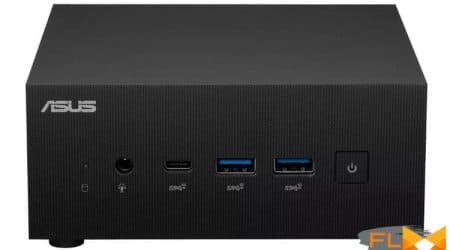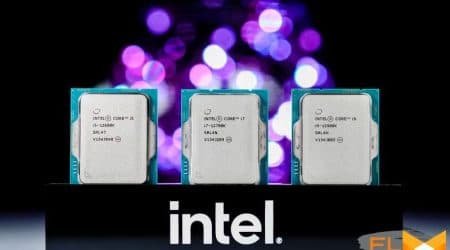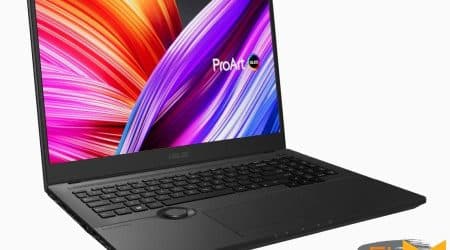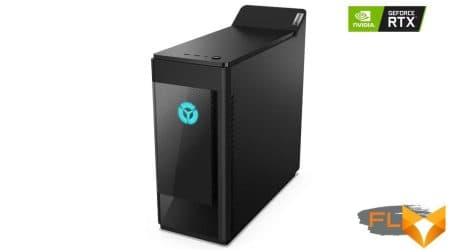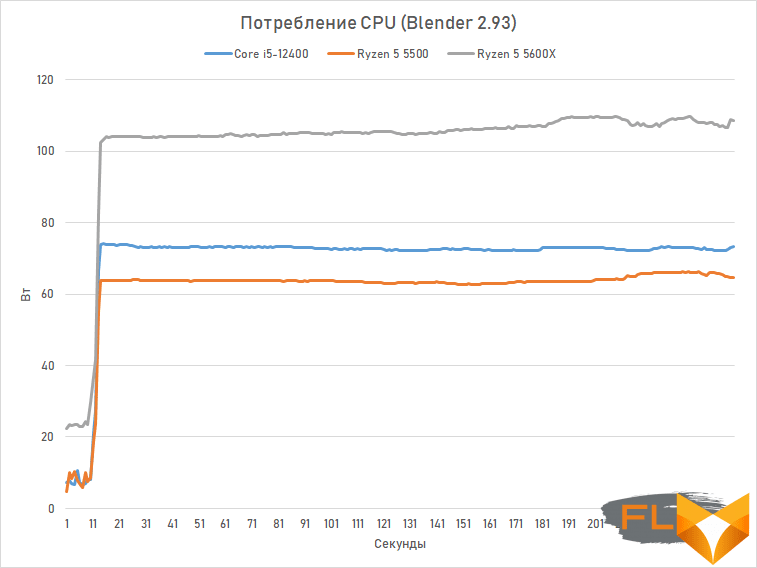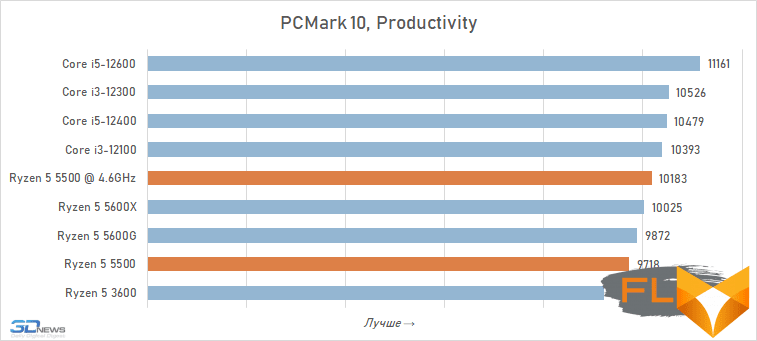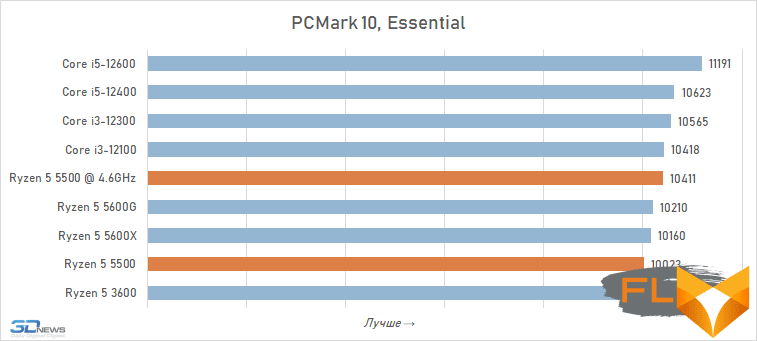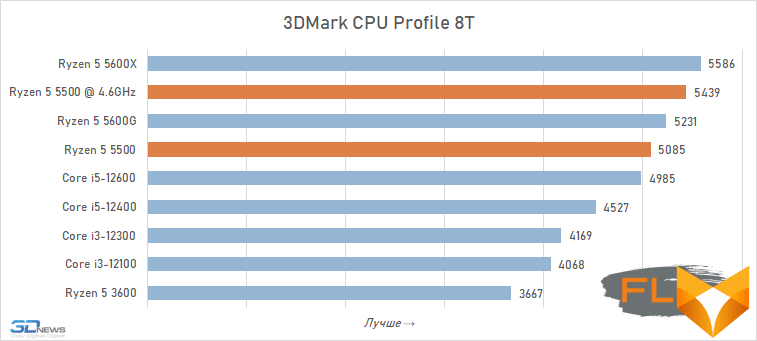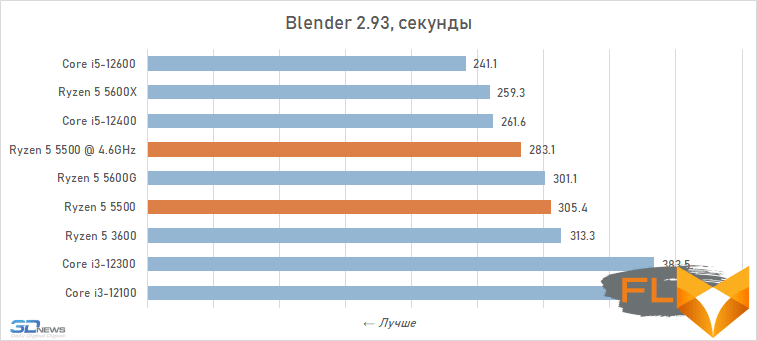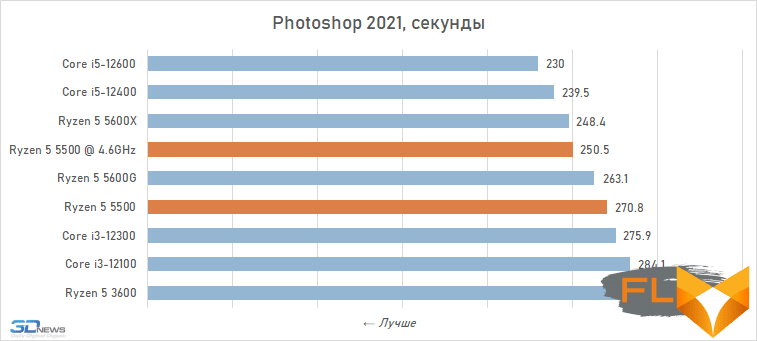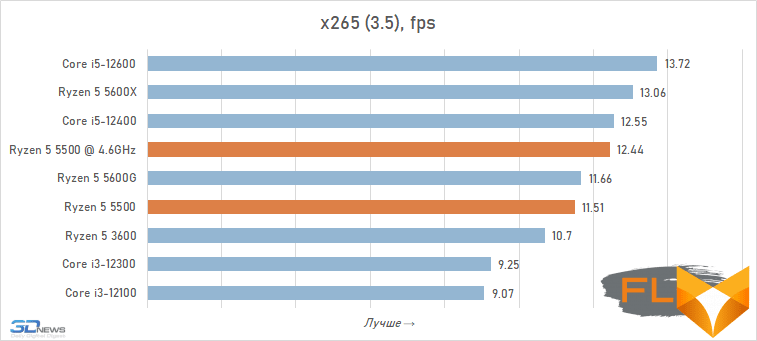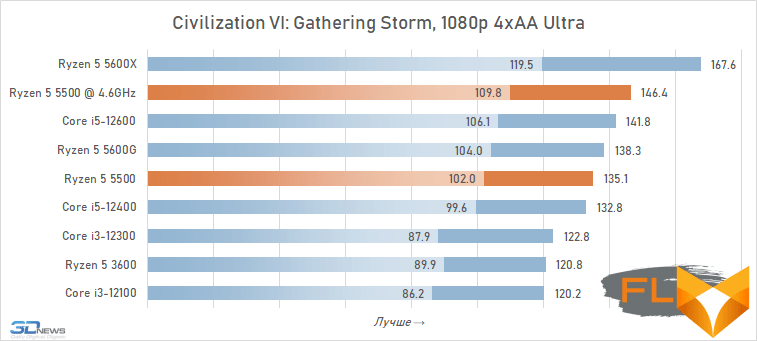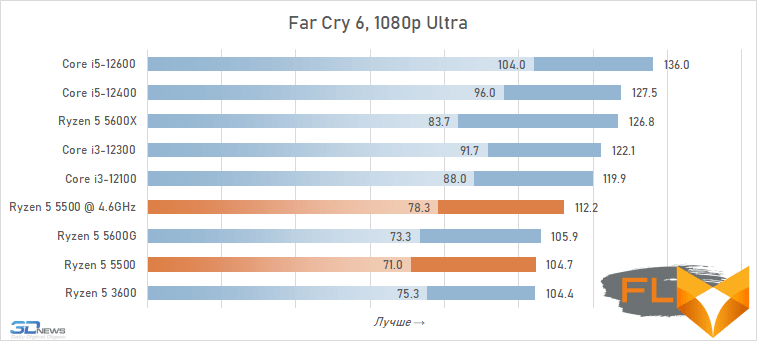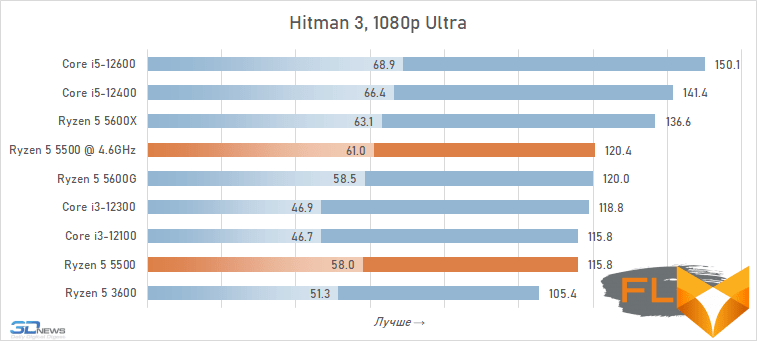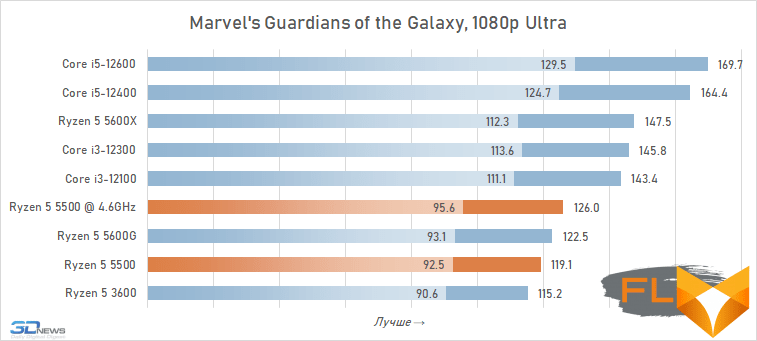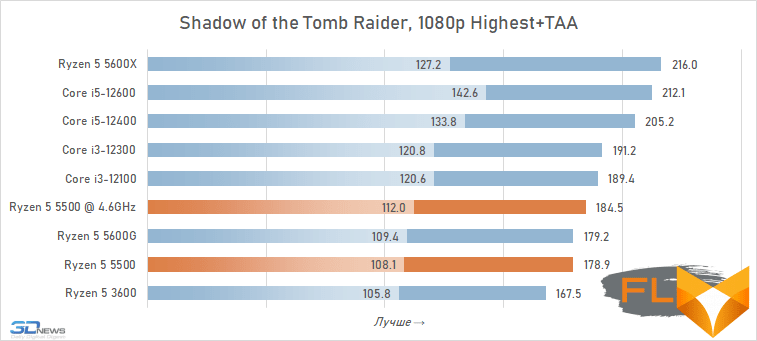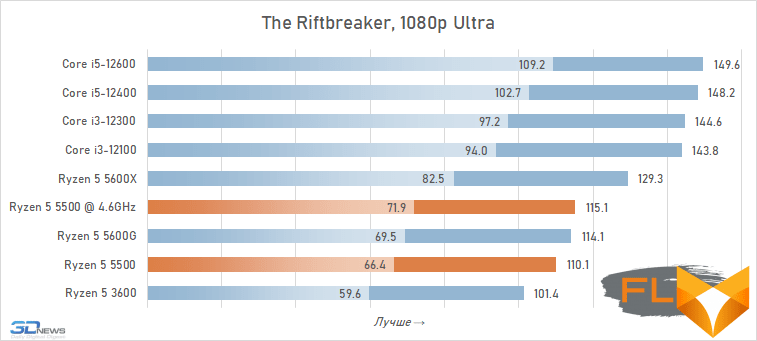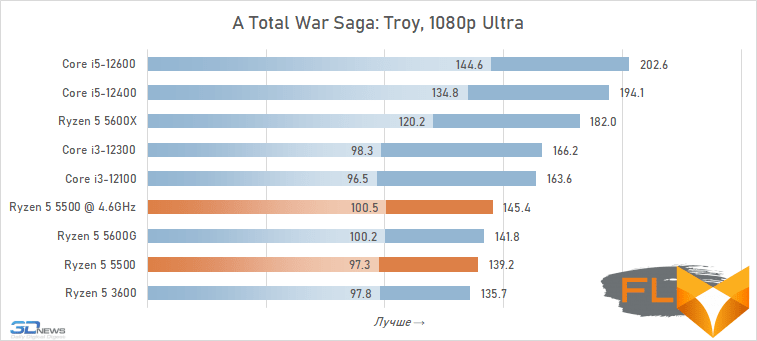


It so happened that the release of the Ryzen 5000 series coincided with the crisis in the semiconductor market and the peak of the chip shortage, as a result of which AMD had to severely limit the diversity of the model range. In November 2020, the company released only one model each with 6, 8, 12 and 16 cores, while the minimum price of the processor with progressive cores Zen 3 was above $300. This approach caused serious dissatisfaction among AMD fans, but the company really had no other choice: the production quotas that it managed to get from its manufacturing partner, TSMC, were not even enough to cover the demand for expensive processors.
However, with the advent of Alder Lake, the situation has changed dramatically. Intel created a very successful family of processors, which, moreover, was introduced almost immediately in all price segments. Because of this, it turned out that with the advent of 2022, there was nothing suitable in the AMD assortment that the company could oppose to competitor shock processors like the Core i5-12600K, Core i5-12400 and Core i3-12100, which very quickly reached the first places in sales statistics. Therefore, as soon as AMD realized that its market position was shaky and its share in the desktop market was rapidly declining, it immediately turned to active responses. Firstly, it very aggressively, by 25-30%, reduced the prices of all available processors of the Ryzen 5000 series. Secondly, the lineup was replenished with several new products at once – affordable eight- and six-core carriers of the Zen 3 microarchitecture.
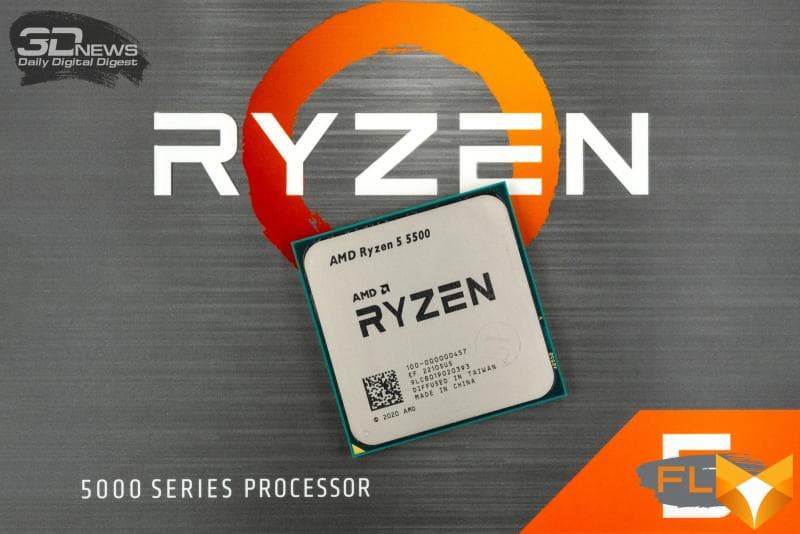
So, since the beginning of April, sales of the $300 eight-core Ryzen 7 5700X and two six-cores began on the world market: the $200 Ryzen 5 5600 and the $160 Ryzen 5 5500. still looks interesting. In the conditions of “normal life”, it should have been the cheapest six-core processor with modern microarchitecture. That is why, as soon as the opportunity arose, we immediately took up detailed testing of this promising product.
It is worth recalling that AMD has already tried to release similar budget six-core processors, which became the cheapest options in their class, such as the Ryzen 5 3500 and 3500X. However, they hit the market only in certain geographical regions and, moreover, were significantly reduced in terms of characteristics. In the Ryzen 5 3500 and 3500X, for example, the company turned off SMT technology, which hit performance hard. But the new Ryzen 5 5500 is a completely different breed of processor. It is available globally, and the SMT technology is in place in it, and the main difference from older brothers is the reduction in the amount of cache memory, which at first glance does not look like a catastrophic loss and makes acquaintance with it only more interesting.
⇡#Ryzen 5 5500 in detail
The Ryzen 5000 lineup has undergone some very noticeable changes this spring. Now it has eight representatives instead of four. The expansion has mostly been downwards, but the new models also include the groundbreaking Ryzen 7 5800X3D with 3D V-Cache technology, which the company is positioning as a kind of gaming flagship. The composition of the family is listed in the table below, and please note that a separate column has been added to it – “Current price”. It shows the retail value of the representatives of the Ryzen 5000 family in the global market after the markdown.
| Cores/Threads | Frequency, GHz | L3, MB | TDP, W | Official price | Current price | |
|---|---|---|---|---|---|---|
| Ryzen 9 5950X | 16/32 | 3.4-4.9 | 64 | 105 | $799 | $559 |
| Ryzen 9 5900X | 12/24 | 3.7-4.8 | 64 | 105 | $549 | $399 |
| Ryzen 7 5800X3D | 8/16 | 3.4-4.5 | 92 | 105 | $449 | $449 |
| Ryzen 7 5800X | 8/16 | 3.8-4.7 | 32 | 105 | $449 | $349 |
| Ryzen 7 5700X | 8/16 | 3.4-4.6 | 32 | 65 | $299 | $299 |
| Ryzen 5 5600X | 6/12 | 3.7-4.6 | 32 | 65 | $299 | $229 |
| Ryzen 5 5600 | 6/12 | 3.5-4.4 | 32 | 65 | $199 | $199 |
| Ryzen 5 5500 | 6/12 | 3.6-4.2 | 16 | 65 | $159 | $159 |
As follows from the table, AMD added two inexpensive six-cores to the lineup at once – Ryzen 5 5600 and Ryzen 5 5500. And if the first of them is just a slightly slower copy of the well-known Ryzen 5 5600X, then the second is something completely different. Bottom line: The Ryzen 5 5500 isn’t another Vermeer-designed CPU that desktop users are used to, it’s actually a Cezanne.
Cezanne Semiconductor Crystal
Therefore, under the cover of the Ryzen 5 5500 there is not a pair of chiplets, but a monolithic semiconductor 7nm crystal, inside of which there are computational cores with cache, a PCI Express controller, and a memory controller. AMD uses exactly the same crystal in processors for mobile computers, as well as in desktop APUs of the Ryzen 5000G series. That is, the graphics core is also physically present in the Ryzen 5 5500, but specifically in this model it is disabled. This means that the Ryzen 5 5500 was released by AMD, including with the aim of selling defective Cezanne crystals with non-working graphics.
As a result, the Ryzen 5 5500 has less L3 cache – instead of the usual 32 MB, it has only 16 MB. Moreover, this cache is also slightly slower than Vermeer-designed processors. While the latency of the L3 cache in the usual Ryzen 5000 is about 40-44 cycles, in the Ryzen 5 5500 it is at the level of 48-52 cycles. This is clearly seen in the graph – it shows the results of measuring latency when accessing data, depending on the amount of this data.
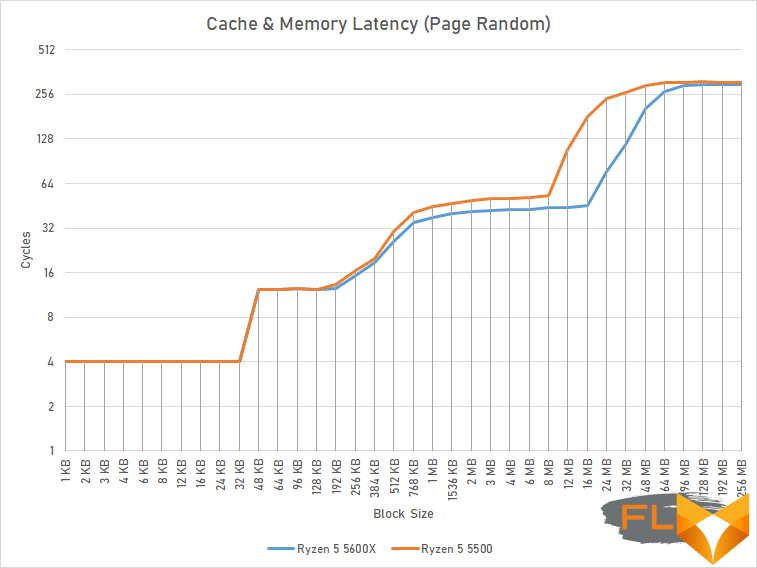
There is another flaw in the characteristics of the Ryzen 5 5500 – support for the old PCIe 3.0 standard instead of the full-fledged PCIe 4.0, which is compatible with more expensive Ryzen with Vermeer design. And this is a very unpleasant feature against the background of the fact that AMD itself in inexpensive graphics cards like the Radeon RX 6400 and 6500 XT began to use the PCIe 4.0 x4 interface, the bandwidth of which is sorely lacking when switching to PCIe 3.0 mode. In addition, the lack of PCIe 3.0 bandwidth can become noticeable when using flagship SSDs, which really need a high-speed version of the interface to unlock their full potential.
Ultimately, the Ryzen 5 5500 can be compared in terms of consumer qualities to the Ryzen 5 5600G running external graphics, with the discount that the APU clock speeds are about 200 MHz higher. However, all these are rather minor disadvantages against the background of the advantages of the Ryzen 5 5500. Despite the low cost, this is an absolutely full-fledged six-core: it is based on cores with the current Zen 3 microarchitecture and can execute 12 computing threads thanks to SMT technology.

Due to the fact that the Ryzen 5 5500 does not contain 12/14nm crystals in its design and operates at relatively low clock frequencies, it boasts good energy efficiency. The specification limits its power consumption limit to 88 W, but in fact, even with a serious multi-threaded load, it almost always fits within 65 W, while maintaining a real operating frequency of 4.25 GHz in both low and high multi-threaded loads. This can be illustrated with CPU power graphs, where we compare the Ryzen 5 5500 with other six-core processors – Ryzen 5 5600X and Core i5-12400 – in the game Horizon Zero Dawn and with resource-intensive multi-threaded rendering in Blender.
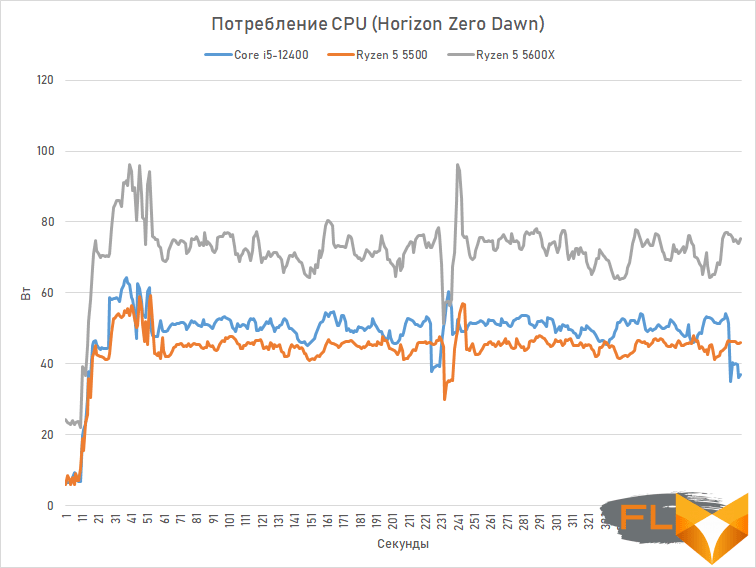
It is clearly seen that the Ryzen 5 5500 is not only much more economical and cooler than the six-core Vermeer, but also outperforms even the Core i5-12400 in terms of energy efficiency, which until recently was the leader in this characteristic. Therefore, within the framework of this review, we are dealing not only with the cheapest, but also with the most economical six-core processor on the market, at least among commonly available solutions with a TDP of 65W.
⇡#Overclocking
The relatively low clock speed of the Ryzen 5 5500 makes me think it should overclock pretty well. However, during practical tests, our copy of the processor refused to confirm this hypothesis. Its operating frequency could only be increased to 4.6 GHz – by about 10% relative to the nominal value.
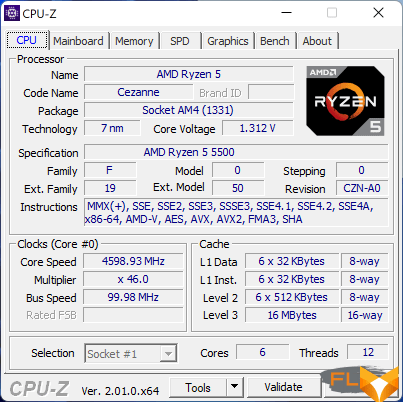
To achieve stability in stress tests at such a frequency, it was necessary to set the voltage to 1.35 V in the BIOS of the motherboard while simultaneously activating the fourth level of Load-Line Calibration. The real supply voltage under load, according to monitoring data, with these settings was 1.3 V.
It’s worth mentioning that with this overclock, the Ryzen 5 5500 continued to maintain a fairly moderate appetite. For example, its power consumption at 4.6 GHz when rendering in Blender increased to 80 W – that is, only 25% of the nominal mode. This means that overclocking the Ryzen 5 5500 does not impose any increased requirements on cooling systems and is available even to those users who buy this processor in a box – complete with a Wraith Stealth cooler.
⇡#Description of the test system and testing methodology
Since the Ryzen 5 5500 is a low-cost hexa-core processor that AMD released to offset the success of the Core i5-12400 and Core i3-12100, the comparison with these members of the Alder Lake family will be the leitmotif of testing. However, the set of test participants is not limited to these three CPUs. Also, the charts below will show the results of the six-core Zen 3 already on the market in the face of the Ryzen 5 5600X and Ryzen 5 5600G, as well as the performance of the most popular member of the Zen 2 generation, the Ryzen 5 3600. The last processor needs to be highlighted – it is still on sale, and its real price in some cases is even lower than the cost of the Ryzen 5 5500.
- Processors:
- AMD Ryzen 5 5600X (Vermeer, 6 cores + SMT, 3.7-4.6GHz, 32MB L3);
- AMD Ryzen 5 5600G (Cezanne, 6 cores + SMT, 3.9-4.4GHz, 16MB L3);
- AMD Ryzen 5 5500 (Cezanne, 6 cores + SMT, 3.6-4.2GHz, 16MB L3);
- AMD Ryzen 5 3600 (Matisse, 6 cores + SMT, 3.6-4.2GHz, 32MB L3);
- Intel Core i5-12600 (Alder Lake, 6P-core + HT, 3.3-4.8GHz, 18MB L3);
- Intel Core i5-12400 (Alder Lake, 6P cores + HT, 2.5-4.4GHz, 18MB L3);
- Intel Core i3-12300 (Alder Lake, 4P cores + HT, 3.5-4.4GHz, 12MB L3);
- Intel Core i3-12100 (Alder Lake, 4P cores + HT, 3.3-4.3GHz, 12MB L3).
- CPU cooler: Noctua NH-D15S.
- Motherboards:
- ASUS ROG Strix X570-E Gaming WiFi (Socket AM4, AMD X570);
- ASUS ROG Strix Z690-F Gaming WiFi (LGA1700, Intel Z690, DDR5 SDRAM).
- Memory:
- 2x16GB DDR4-3600 SDRAM, 16-18-18-38 (Crucial Ballistix RGB BL2K16G36C16U4BL);
- 2x16GB DDR5-6000 SDRAM, 38-38-38-76 (G.Skill Trident Z5 RGB F5-6000U4040E16GX2-TZ5RK).
- Video Card: NVIDIA GeForce RTX 3090 Founders Edition (GA102, 1395-1695/19500MHz, 24GB GDDR6X 384-bit).
- Disk subsystem: Intel SSD 760p 2TB (SSDPEKKW020T8X1).
- Power supply: Thermaltake Toughpower DPS G RGB 1000W Titanium (80 Plus Titanium, 1000W).
All compared processors were tested with canceled artificial consumption restrictions. This means that the PPT limits (for the AMD platform) and PL1/PL2 (for the Intel platform) are ignored, instead the maximum possible frequencies are used in order to obtain maximum performance.
The Ryzen 5 5500 processor has been tested twice: both at nominal frequencies and when overclocked to 4.6 GHz.
The memory subsystems were configured using XMP profiles. Socket AM4 processors were tested with DDR4-3600, and Alder Lake with DDR5-6000.
Testing was performed on the Microsoft Windows 11 Pro (21H2) Build 22000.282.0 operating system with KB5005635 and KB5006746 updates installed and using the following driver set:
- AMD Chipset Driver 4.03.03.431;
- Intel Chipset Driver 10.1.18838.8284;
- Intel SerialIO Driver 30.100.2105.7;
- Intel Management Engine Interface 2124.100.0.1096;
- NVIDIA GeForce 512.16 Driver.
Description of the tools used to measure computing performance:
Comprehensive benchmarks:
- Futuremark PCMark 10 Professional Edition 2.1.2508 – testing in Essentials scenarios (typical work of the average user: launching applications, surfing the Internet, video conferencing), Productivity (office work with a word processor and spreadsheets), Digital Content Creation (creating a digital content: photo editing, non-linear video editing, rendering and visualization of 3D models).
- 3DMark Professional Edition 2.22.7336 – testing in the CPU Profile 1.1 scenario with eight active threads and at the maximum possible processor load.
Applications:
- 7-zip 21.02 – archiving speed testing. The time taken by the archiver to compress a directory with various files with a total volume of 3.1 GB is measured. Uses LZMA2 algorithm and maximum compression ratio.
- Adobe Photoshop 2021 22.4.3 – Graphics performance testing. The average execution time of the Puget Systems Adobe Photoshop CC Benchmark 18.10 test script, which simulates the typical processing of an image taken by a digital camera, is measured.
- Adobe Photoshop Lightroom Classic 10.3 – Performance test for batch processing of a series of RAW images. The test scenario includes post-processing and export to JPEG at a resolution of 1920 × 1080 and a maximum quality of two hundred 16-megapixel RAW images taken with a Fujifilm X-T1 digital camera.
- Adobe Premiere Pro 2021 15.4.0 – performance testing for non-linear video editing. This measures the rendering time to YouTube 4K for a project containing HDV 2160p30 footage with various effects applied.
- Blender 2.93.5 – testing the speed of the final rendering in one of the popular free packages for creating three-dimensional graphics. The duration of building the final model pavillon_barcelona_v1.2 from Blender Benchmark is measured.
- Mathworks Matlab R2021b (9.11.0) – testing the speed of engineering and mathematical calculations in a popular mathematical package. A standard benchmark is used, which includes matrix and vector operations, the solution of differential and symmetric sparse linear systems of equations, as well as the construction of 2D and 3D plots.
- Microsoft Visual Studio 2017 (15.9.40) – compile time measurement of a large MSVC project – a professional package for creating 3D graphics Blender version 2.79b.
- Stockfish 14.1 – testing the speed of the popular chess engine. The speed of enumeration of options in the position “1q6/1r2k1p1/4pp1p/1P1b1P2/3Q4/7P/4B1P1/2R3K1 w” is measured.
- SVT-AV1 v0.8.6 – testing the speed of video transcoding to the promising AV1 format. Performance is measured using a raw 1080p@50FPS AVC video file with a bitrate of about 30 Mbps.
- Topaz Video Enhance AI v2.3.0 – performance testing in an AI-based program to improve video detail. The test uses the original video at 640×360 resolution, which is doubled using the Artemis Anti Aliasing v9 model.
- V-Ray 5.00 – Benchmark the performance of a popular rendering system using the standard V-Ray Benchmark Next application.
- x265 3.5+8 10bpp – testing the speed of video transcoding to H.265/HEVC format. To evaluate performance, we use the original 2160p@24FPS AVC video file with a bitrate of about 42 Mbps.
Games:
- Chernobylite. Resolution 1920 × 1080: Graphics Quality = Ultra.
- Civilization VI: Gathering Storm. Resolution 1920×1080: DirectX 12, MSAA=4x, Performance Impact=Ultra, Memory Impact=Ultra.
- Cyberpunk 2077. 1920×1080 resolution: Quick Preset = Ray Tracing – Ultra.
- Far Cry 6. 1920 × 1080 resolution: Graphics Quality = Ultra, HD Textures = On, Anti-Aliasing = TAA.
- Hitman 3. 1920 × 1080 resolution: Super Sampling = 1.0, Level of Detail = Ultra, Texture Quality = High, Texture Filter = Anisotropic 16x, SSAO = Ultra, Shadow Quality = Ultra, Mirrors Reflection Quality = High, SSR Quality = High, Variable Rate Shading = Quality.
- Horizon Zero Dawn. Resolution 1920 × 1080: Preset = Ultimate Quality.
- Marvel’s Guardians of the Galaxy. Resolution 1920 × 1080: Graphics Preset = Ultra.
- Serious Sam: Siberian Mayhem. Resolution 1920 × 1080: Direct3D 11, CPU Speed = Ultra, GPU Speed = Ultra, GPU Memory = Ultra.
- Shadow of the Tomb Raider. Resolution 1920 × 1080: DirectX12, Preset = Highest, Anti-Aliasing = TAA.
- The Riftbreaker. Resolution 1920 × 1080: DirectX12, Texture Quality = High, Raytraced soft shadows = On, Ray traced shadow quality = Ultra, Raytraced ambient occlusion = On.
- A Total War Saga: Troy. Resolution 1920 × 1080: DirectX 12, Quality = Ultra, Unit Size = Extreme.
- Watch Dogs Legion. Resolution 1920 × 1080: DirectX 12, Quality = Ultra, RTX = Off, DLSS = Off.
In all gaming tests, the results are the average number of frames per second, as well as the 0.01-quantile (first percentile) for FPS values. The use of the 0.01-quantile instead of the minimum FPS is due to the desire to clean up the results from random bursts of performance that were provoked by reasons not directly related to the operation of the main components of the platform.
⇡#Performance in complex benchmarks
The performance of the Ryzen 5 5500 in PCMark 10, a test that gives a comprehensive assessment of systems in their daily use, looks quite expected. The benchmark puts the Ryzen 5 5500 above the Ryzen 5 3600, but below the Ryzen 5 5600X and Ryzen 5 5600G in all workloads, both office and media content processing. At the same time, overclocking improves its performance and allows you to overtake the Ryzen 5 5600G in resource-intensive work scenarios and the Ryzen 5 5600X in everyday activities in office and Internet applications.
However, the performance of the Ryzen 5 5500, like other processors with the Zen 3 architecture, looks rather weak next to the results of Alder Lake. In two out of three scenarios, any six-core Ryzen lose even to a quad-core Core i3-12100. And in the most “heavy” version of the Digital Content Creation load, where the number of cores plays a significant role, the Ryzen 5 5500 under consideration is only comparable to the Core i3-12300.
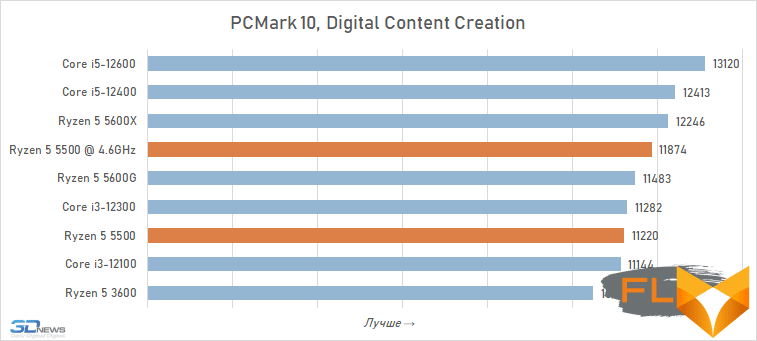
At the same time, the situation in the near-game 3DMark CPU Profile test looks somewhat different. This benchmark simulates the game environment (the physical environment and the actions of abstract NPCs) using the multi-threaded capabilities of processors and modern vector instruction sets. And in this case, the results of the Ryzen 5 5500 are much closer to those of the six-core Alder Lake. Moreover, in the eight-thread version of the test, it generally takes the first positions, not only ahead of the Core i5-12600, but also almost overtaking its more expensive brother Ryzen 5 5600X with the help of overclocking.
However, in the subtest that uses all the available multi-threaded CPU capabilities, the alignment of forces is somewhat different. In this case, the Ryzen 5 5500 lags behind the Core i5-12600 and Core i5-12400 at the nominal frequency, but its overclocking to 4.6 GHz still allows you to get a result slightly higher than that of the younger six-core Alder Lake.
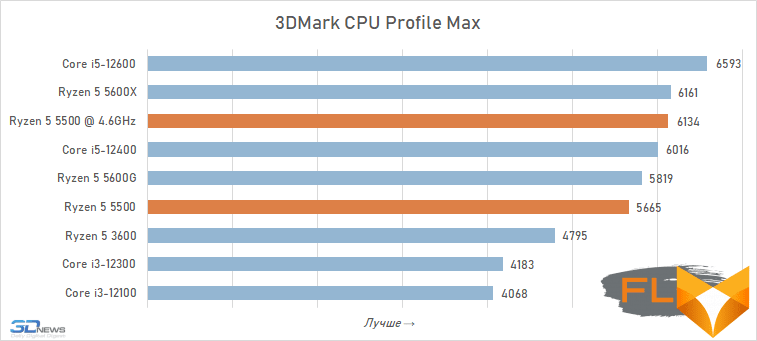
⇡#Performance in Applications
According to the results of tests in resource-intensive applications, the performance picture of the Ryzen 5 5500 is quite complete. This processor is indeed the simplest of the six-core Zen 3, which, due to the reduced L3 cache and low clock speed, lags behind both the Ryzen 5 5600X and the Ryzen 5 5600G. However, his positioning is such that he should not be faster than them. But on the other hand, it is clearly better than the old, but still popular Ryzen 5 3600 – the performance of the Ryzen 5 5500 turned out to be higher in 10 applications out of 12. Moreover, if you resort to overclocking, the Ryzen 5 5500 performance can be improved by about 7%. And this is enough to overtake the Ryzen 5 5600G. However, the new product cannot get close in performance to the Ryzen 5 5600X in any resource-intensive application, either in nominal value or taking into account the artificially increased clock frequency.
At the same time, the performance of the Ryzen 5 5500 is clearly not enough to be opposed to the six-core Intel of the current generation. Among the test tasks, there was not a single one where the Ryzen 5 5500 would be faster than the Core i5-12400. And even when overclocked, it manages to outperform the younger six-core Alder Lake in only three tasks from a test set that includes a dozen resource-intensive applications. In other words, in terms of performance in “heavy” scenarios with a professional bias, the Ryzen 5 5500 looks like a slightly overrated solution – with such performance, it should still cost significantly less than the Core i5-12400.
But if we compare the Ryzen 5 5500 with the quad-core Core i3-12300, then in this case, the clear advantage remains with the AMD processor. Due to the one and a half times superiority in the number of cores, the six-core is on average 20% faster, but in some cases it can provide a 25% advantage.
Rendering:
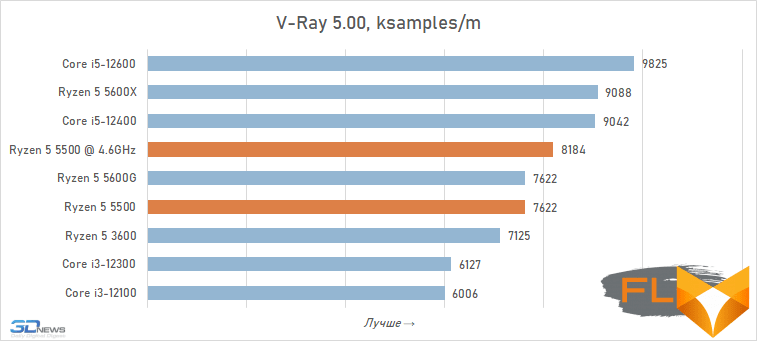
Photo processing:

Video work:

Video transcoding:
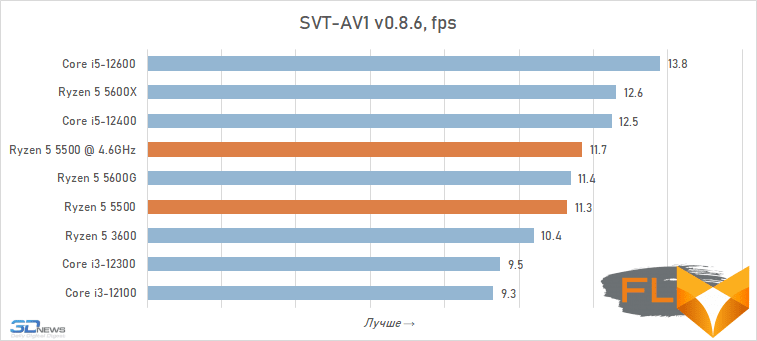
Compilation:

Archiving:
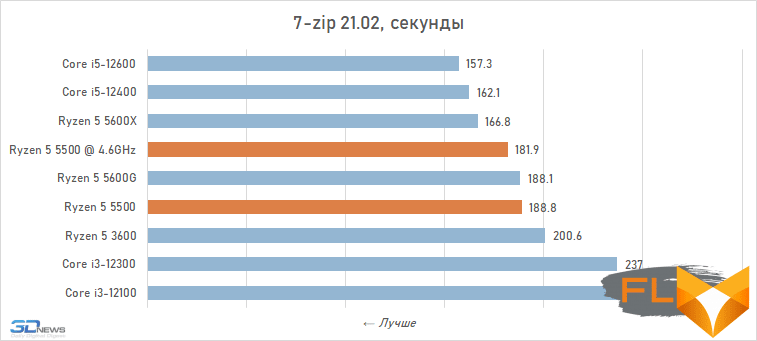
Chess:
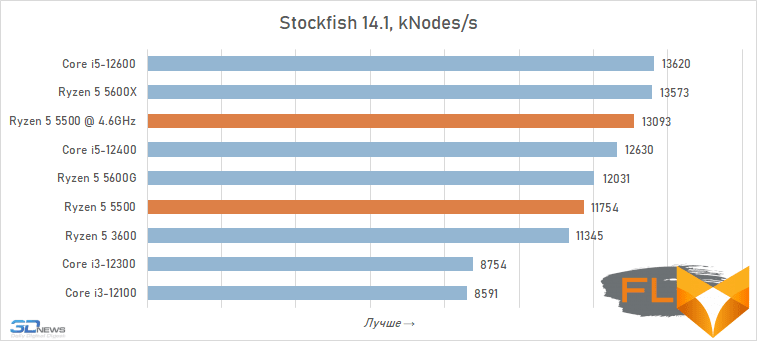
Mathematical calculations:

⇡#Game performance
The size of the cache memory has a huge impact on the performance of Ryzen processors in games, which is why the Ryzen 7 5800X3D with a tripled L3 cache appeared in the AMD arsenal. But the opposite is also true – reducing the amount of cache memory entails a drop in gaming performance. That’s why you can’t expect much from the Ryzen 5 5500 – this processor is based on the Cezanne design, in which the L3 cache is cut down to 16 MB. The low clock frequency of this CPU also contributes.
Ultimately, in terms of average gaming performance, which we calculated for 12 modern titles, the Ryzen 5 5500 is slower than the Ryzen 5 5600X (in Full HD) by a rather impressive 17%. In fact, although we are talking about a representative of the Zen 3 family, in terms of frame rate it turns out to be much closer to the Ryzen 5 3600 than to current generation processors. And of course, there can be no talk of any rivalry on an equal footing with Alder Lake in this case. Even the younger quad-core Core i3-12100, which costs more than one and a half times cheaper, turns out to be 9% faster in games than the Ryzen 5 5500.
Moreover, the situation cannot be corrected by overclocking the Ryzen 5 5500 to 4.6 GHz. Yes, the average FPS rises slightly from this, but AMD’s junior six-core processor still remains slower than not only six-core, but also quad-core competitor processors.
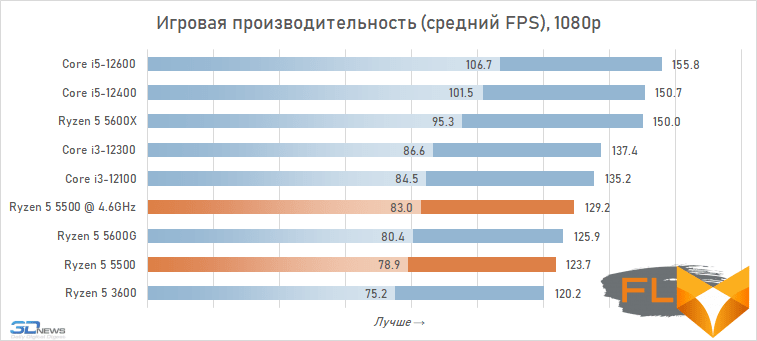
The relatively low gaming performance of the Ryzen 5 5500 can be seen in almost all games from our test set. Even in situations that are quite favorable for AMD solutions, for example, in Chernobylite, the new Serious Sam and Shadow of the Tomb Raider, the protagonist of this review looks rather weak, demonstrating an advantage only over the old Ryzen 5 3600.

⇡#Conclusions
AMD has finally taken the step that fans have been waiting for from it for a long time: with the release of the Ryzen 5 5500, it has drastically reduced the price you have to pay to own a Zen 3 microarchitecture carrier. $159, which is almost half the manufacturer’s recommended price for the Ryzen 5 5600X. Moreover, the Ryzen 5 5500 turned out to be the most affordable six-core processor with a modern architecture in general, since the price of the younger six-core Alder Lake, Core i5-12400F, is slightly higher at $167.
However, all of the above are rather dubious achievements. If the Ryzen 5 5500 came out six months ago, when inexpensive Alder Lake did not yet exist, such a processor would certainly attract attention as an inexpensive and high-performance solution for mid-range systems. But today it is impossible to consider it as such – against the background of representatives of the Alder Lake family, the new Ryzen 5 5500, like many other Ryzen 5000 desktop models, looks quite faded.
Benchmarks show that the Ryzen 5 5500 lags noticeably behind the performance of today’s six-core Intel processors in applications of any type. And if in resource-intensive tasks for creating and processing digital content, the performance of the Ryzen 5 5500 can be at least a little closer to the level of the Core i5-12400 due to overclocking, then in games its lag reaches tens of percent and looks completely hopeless. And this is quite natural – the reduction of the L3 cache in processors with the Zen 3 microarchitecture seriously undermines their gaming performance. Therefore, for example, the frame rate that the Ryzen 5 5500 allows you to get with 16 MB L3 cache turns out to be much closer to the performance of the old Ryzen 5 3600, and not the more recent Ryzen 5 5600X.
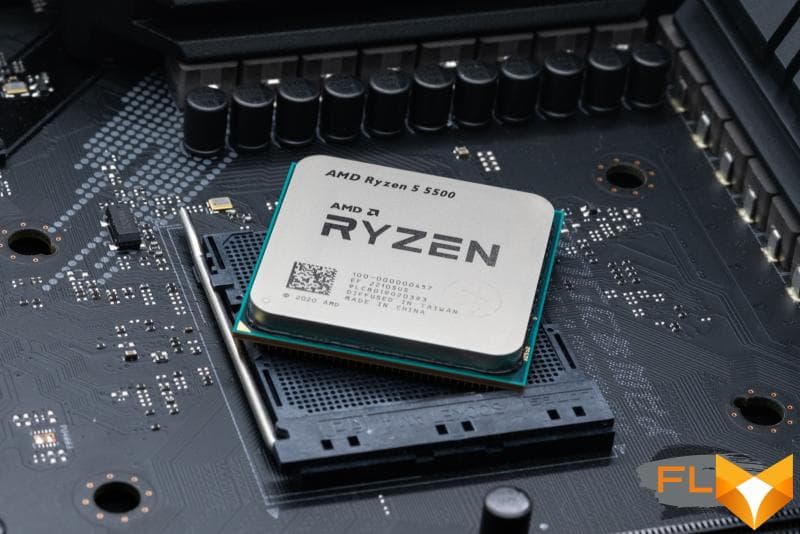
But even worse for the Ryzen 5 5500 is that it cannot be called a full-fledged competitor to the quad-core Core i3-12100 and Core i3-12300 processors. Yes, in terms of multi-threaded performance in computing applications, it looks better, but in terms of frame rates in games, even such representatives of the Alder Lake family turn out to be faster, despite the smaller number of cores. As a result, it turns out that in a whole class of common tasks, the new AMD processor is inferior not only to equivalent, but also to significantly cheaper Intel alternatives.
In other words, the Ryzen 5 5500 is not able to solve the global problem that, as it initially seemed, it should solve. In terms of strengthening the competitive position of the Ryzen 5000 lineup, the release of this processor does not change anything. In terms of price and performance, it can hardly be called an attractive offer, where this CPU (for obvious reasons) is sold much more expensive than it should. Therefore, the Ryzen 5 5500 may be of interest only to those users who want to carry out an inexpensive upgrade of existing old Socket AM4 systems by transferring them to a processor with the current microarchitecture. Fortunately, Ryzen 5 5500 support should be provided by all motherboards with the appropriate socket – for full compatibility with the new product, a BIOS update is enough (for a version based on AGESA 1.2.0.7).
FAQ Ryzen 5 5500 review
How do the integrated graphics in the Ryzen 5 5600G compare to dedicated AMD Radeon GPUs for 1080p gaming?
The integrated graphics in the Ryzen 5 5600G, while capable for basic gaming, typically do not match the performance of dedicated AMD Radeon GPUs, especially for demanding 1080p gaming scenarios.
What is the boost clock speed of the Ryzen 5500, and how does it impact gaming performance?
The Ryzen 5500 has a boost clock speed of up to 4.2GHz, which enhances its gaming performance by allowing the CPU to handle more intensive tasks faster, benefiting games that rely heavily on CPU power.
How do the Ryzen 5500 and 5600 compare as budget CPUs for a gaming PC?
As budget CPUs for a gaming PC, both the Ryzen 5500 and 5600 offer great value, with the 5600 generally providing slightly better performance due to its integrated GPU, making it a more versatile choice.
What features make the Ryzen 5500 a suitable desktop processor for budget PCs?
The Ryzen 5500, with its 6 cores and 12 threads, offers solid performance for budget PCs, especially when paired with DDR4 RAM and a dedicated GPU, making it a cost-effective choice for everyday computing and gaming.
How does the Zen 3 CPU architecture benefit the Ryzen 5 series CPUs like the 5500 and 5600?
The Zen 3 CPU architecture in the Ryzen 5 series CPUs like the 5500 and 5600 enhances their efficiency and performance, particularly in single-threaded and multi-threaded tasks, making them competitive with Intel’s counterparts.
According to Tom’s Hardware, how does the Ryzen 5500 perform in gaming compared to Intel’s similar offerings?
According to Tom’s Hardware, the Ryzen 5500 performs competitively in gaming compared to similar offerings from Intel, often providing better multi-threaded performance at a similar or lower price point.
Can the R5 5500 handle games at 1440p resolution effectively?
The R5 5500 can handle games at 1440p resolution effectively when paired with a powerful dedicated GPU, as its CPU performance is sufficient to manage gaming workloads at this resolution.
What is the base clock of the Ryzen 5500, and how does it affect its performance in PCs?
The base clock of the Ryzen 5500 is 3.6GHz, providing a solid foundation for general performance in PCs, ensuring efficient handling of everyday tasks and gaming.
How do the Ryzen 5000 processors, like the 5500 and 5600G with the iGPU, cater to different needs in new PCs?
The Ryzen 5000 processors cater to different needs; the 5500 is an affordable option for those with a dedicated GPU, while the 5600G with the iGPU is ideal for budget PCs where a separate GPU is not feasible.
What are the benefits of simultaneous multithreading in the 6-core, 12-thread Ryzen 5 5500 for gaming and multitasking?
Simultaneous multithreading in the 6-core, 12-thread Ryzen 5 5500 allows each core to handle two threads simultaneously, improving performance in multi-threaded applications and enhancing gaming and multitasking capabilities.
